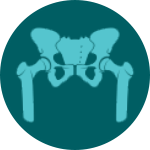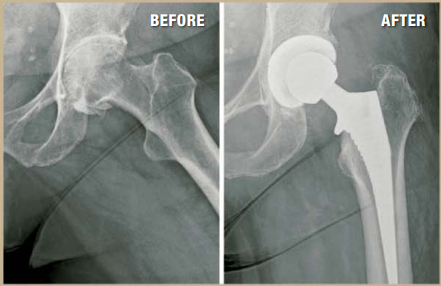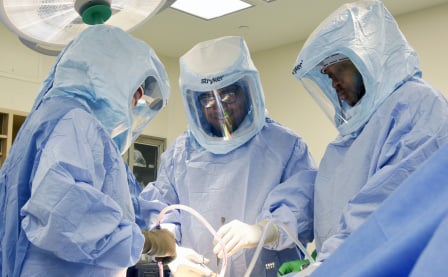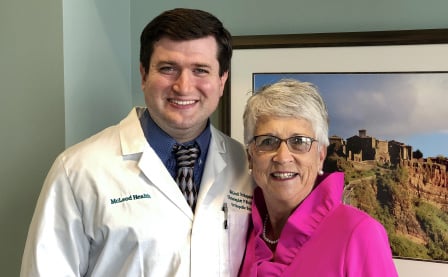


What We Do
Select a category below to learn more.
Total Hip Replacement
Total hip replacement can relieve pain and allow individuals to live a more active, fuller life. There are several types of hip replacement surgery available to patients, including traditional hip replacement or minimally invasive hip replacement. In a traditional hip replacement, the surgeon must make an eight- to 10-inch incision to open the hip for the surgery to take place. With the minimally invasive hip replacement procedure, the surgeon can perform the surgery through two to three smaller incisions.

Direct Anterior Approach
Thanks to new equipment and technology, patients suffering from debilitating hip pain now have a new option for relief. The Direct Anterior Approach is performed without detaching any of the stabilizing muscles around the hip, leading to a smaller incision with minimal scarring, a shorter hospital stay and potentially faster recovery. During the procedure, the surgeon reaches the hip joint from the front of the hip as opposed to the side or the back.
This less invasive surgery is especially appropriate for patients who are active and eager to return to work and their daily activities as quickly as possible. The patient’s return to normal activity typically occurs in a matter of weeks as opposed to months.
Revision
Millions of people are enjoying the quality of life and end of pain that a total hip joint replacement delivers. Many of those people will also experience the need for a second replacement – also called a “revision” – of their artificial joint. Over time, the same wear and tear that led to the initial joint replacement can cause loosening of the replacement. Occasionally, the implant will shift out of its normal position because of a new fracture, loosening or scar tissue.

Revision surgery generally is more complex and takes longer, because unlike the original joint replacement procedure, this surgery involves removing the old implant, preparing the site for the new implant, and implanting the new components. Various techniques are used for the new joints, as well as various cemented and uncemented techniques, to ensure stability of the new joint.
Other Hip Conditions
McLeod Orthopedic Specialists diagnose the cause and treat the following hip problems:
- Arthritis and Osteoarthritis
- Deformity or Genetic Conditions
- Fracture or Dislocation
- Hip Dysplasia
- Loose Hip Joint
- Pain, Numbness, or Swelling
Patient Success Stories

Dannie McLellan of Darlington needed a hip replacement and was determined to find an Orthopedic Surgeon that offered the minimally invasive Direct Anterior Approach. To read more about Dannie’s story in McLeod Magazine and what led her to McLeod Health Seacoast, click here.

An anterior hip replacement from orthopedic surgeon Dr. Chad Thurman helped Jeri Porter, the head women’s basketball coach at Francis Marion University, get back in the game. To read more about Jeri’s story in McLeod Magazine, click here.
-
McLEOD REGIONAL MEDICAL CENTER FLORENCE
843-777-2000 -
McLEOD DARLINGTON
843-777-1100 -
McLEOD DILLON
843-774-4111 -
McLEOD LORIS
843-716-7000 -
McLEOD SEACOAST
843-390-8100 -
McLEOD CHERAW
843-537-7881 -
McLEOD CLARENDON
803-433-3000



-
McLEOD REGIONAL MEDICAL CENTER FLORENCE
843-777-2000 -
McLEOD DARLINGTON
843-777-1100 -
McLEOD DILLON
843-774-4111 -
McLEOD LORIS
843-716-7000 -
McLEOD SEACOAST
843-390-8100 -
McLEOD CHERAW
843-537-7881 -
McLEOD CLARENDON
803-433-3000